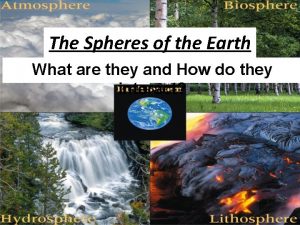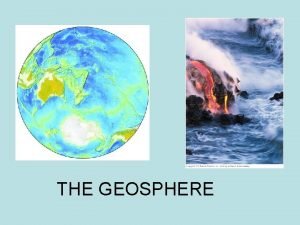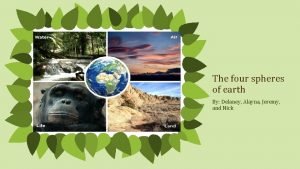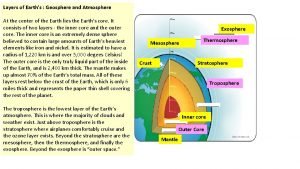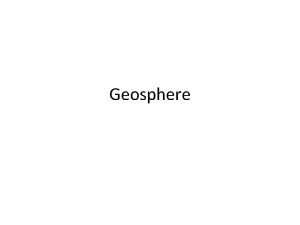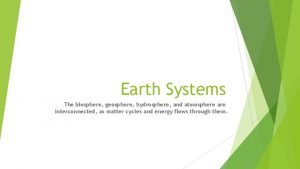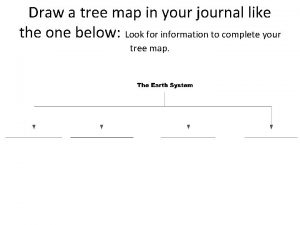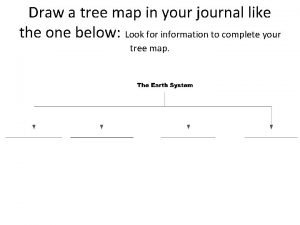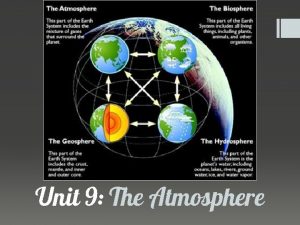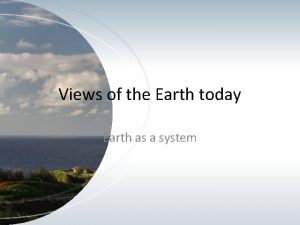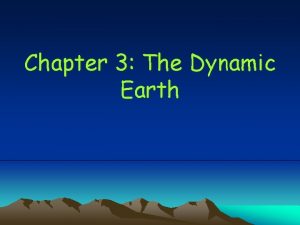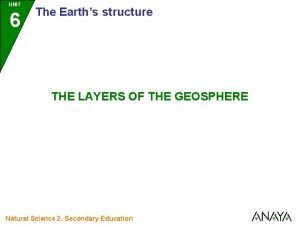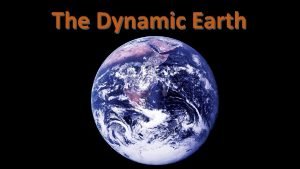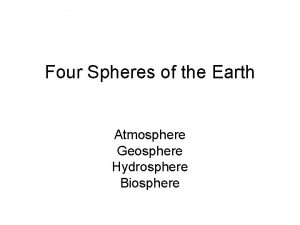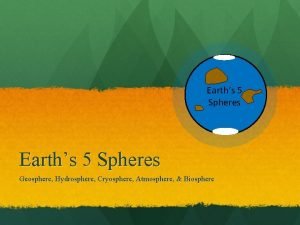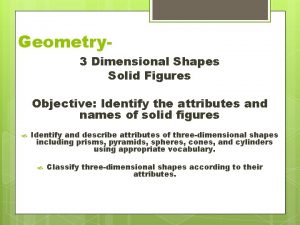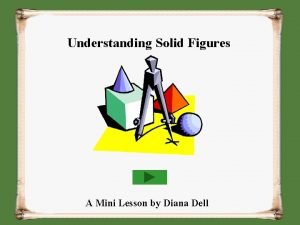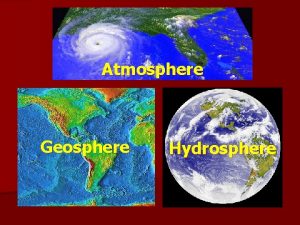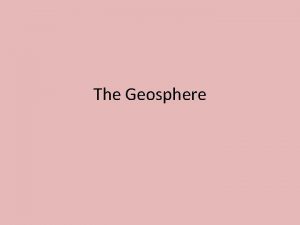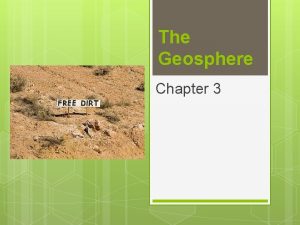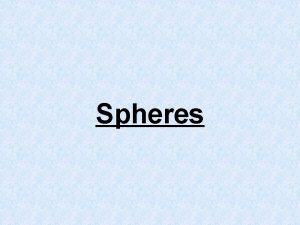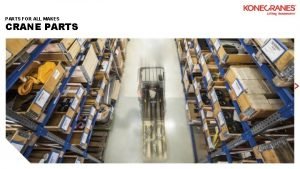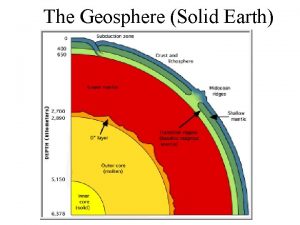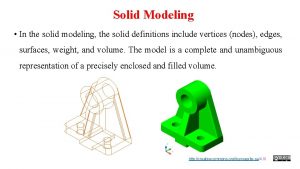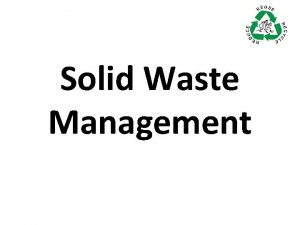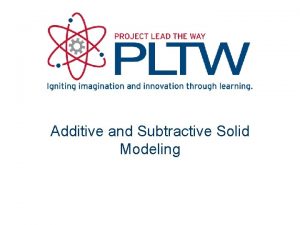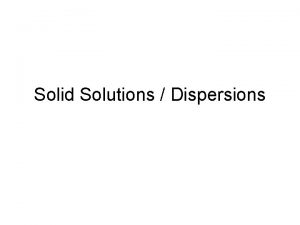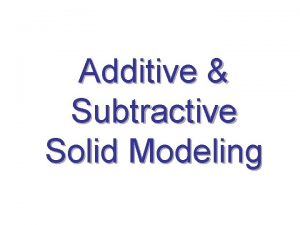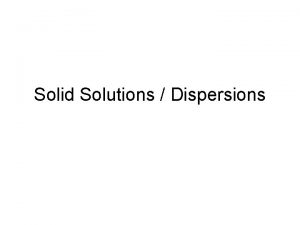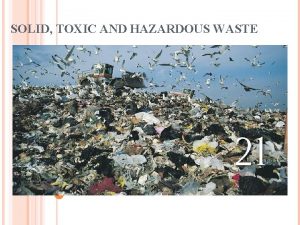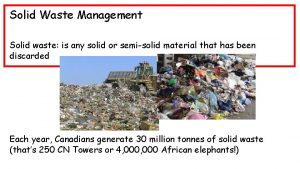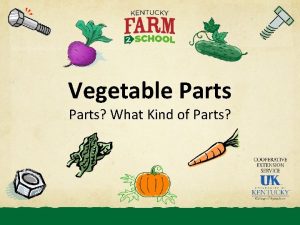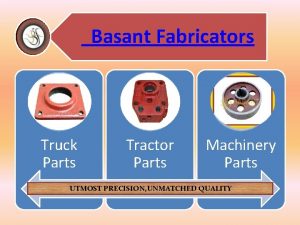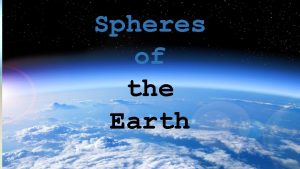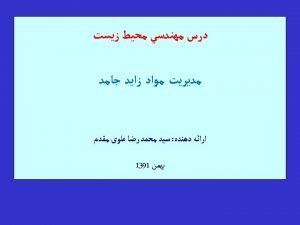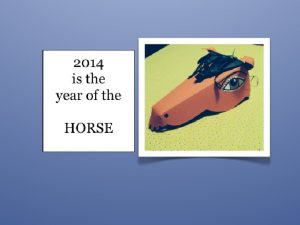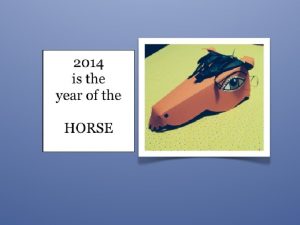What is the GEOSPHERE All solid parts of



































- Slides: 35

What is the GEOSPHERE? �All solid parts of Earth �Rocks, soils, minerals, sediments, magma The Grand Canyon, AZ

What are the layers of the Earth? https: //www. youtube. com/watch ? v=Wwii. Ojyfv. AU

Layers of the Earth • Geologists classify Earth’s layers two ways: chemically and physically • Chemical – by composition • Physicalbyofstructure Chemical Layers the Earth 1. Crust- O, Si, Al 2. Mantle- O, Si, Mg, Fe 3. Core- Fe, Ni

Physical Layers of the Earth • Lithosphere – Crust and upper mantle combined – Broken in chunks called tectonic plates – Oceanic plates are thinner and denser than continental plates • Asthenosphere - Layer of Jello-like magma in the mantle - Tectonic plates move due to

Physical Layers, cont. �Mesosphere �The rest of the mantle; molten rock �Outer Core �Liquid metal �Surrounds inner core �Inner Core �Densest layer �Solid metal


Theory of Plate Tectonics �Lithosphere (upper mantle and crust) is divided into pieces called tectonic plates. �These plates glide across the underlying asthenosphere like ice drifts across a pond. �Continents are located on tectonic plates and move around with them


Seafloor Spreading 1. Magma rises from asthenosphere 2. Creates new oceanic lithosphere 3. Pushes tectonic plates apart


Seafloor-Spreading



If new crust is being created by the process of seafloor spreading, is the Earth growing!?

Subduction �Subduction zones: A region where old crust is destroyed as it is pulled back down into the mantle

Plate Boundaries �The area where two plates meet is called a plate boundary. �Most earthquakes and volcanoes occur at or near plate boundaries Three main types of plate boundaries: 1. Divergent- separating 2. Convergent- colliding 3. Transform- scraping past



Transform Boundaries • 2 plates slide past each other • Not smooth. Plates lock, and build up tension. After too much tension builds, the plates “snap” causing earthquakes


Divergent Boundaries • When two plates separate • Most common on ocean floor • Creates Mid-Ocean Ridge

Divergence Forms New Ocean Floor

Convergent Boundaries Three Main Types: 1. Continental & Oceanic- causes deep ocean trench and land volcanoes Ex: Andes Mountains 2. Continental & Continental- causes large land mountain ranges Ex: Himalayan Mountains 3. Oceanic & Oceanic- causes deep ocean trench and island arc (chain of volcanic

Subduction Zone Continental + Oceanic Crust

Continental + Continental Crust

Subduction Zone Oceanic + Oceanic Crust (another view)

Subduction Zone Oceanic + Oceanic Crust


Some videos for your viewing pleasure… Plate Movement: https: //www. youtube. com/watch? v=kwf. NGatx. UJI � http: //www. youtube. com/watch? v=ryr. XAGY 1 dm. E&fea ture=endscreen&NR=1 San Andreas Fault: � http: //www. youtube. com/watch? NR=1&v=Zx. PTLmg 0 ZCw&feature =endscreen

Exit Ticket � 1. Arrows in the block diagram below show the relative movement along a tectonic plate boundary. What is this type of plate boundary called? a. b. c. d. transform plate boundary convergent plate boundary divergent plate boundary subduction plate boundary

Exit Ticket � 2. When two tectonic plates collide, oceanic crust usually subducts beneath continental crust because oceanic crust is primarily composed of igneous rock that is: a. b. c. d. thin and less dense thick and less dense thin and more dense thick and more dense

Exit Ticket � 3. The block diagram below shows the boundary between two tectonic plates. Which type of plate boundary is shown? a. divergent b. transform c. convergent d. complex

Exit Ticket � 4. The Himalaya Mountains were formed in a collision at a: a. divergent boundary b. convergent boundary c. transform boundary d. fracture zone

Exit Ticket � 5. In which Earth layer are most convection currents that cause seafloor spreading thought to be located? a. b. c. d. crust outer core asthenosphere inner core

Tectonic Plates Active Volcanoes Earthquakes Worldwide
 Opposite rays
Opposite rays Honors its atomic
Honors its atomic Ex of solid solution
Ex of solid solution Covalent network solid vs molecular solid
Covalent network solid vs molecular solid Crystallography types
Crystallography types Crystalline solid
Crystalline solid Crystalline solid and amorphous solid
Crystalline solid and amorphous solid Crystalline substances
Crystalline substances When a solid completely penetrates another solid
When a solid completely penetrates another solid Interpenetration of solids
Interpenetration of solids Evaporation separation example
Evaporation separation example Biosphere examples
Biosphere examples Elements of the geosphere
Elements of the geosphere Defenition of earth
Defenition of earth The layers of the geosphere
The layers of the geosphere Bill nye geosphere
Bill nye geosphere Geosphere atmosphere hydrosphere and biosphere
Geosphere atmosphere hydrosphere and biosphere Geosphere
Geosphere Sphere interactions examples
Sphere interactions examples Geosphere drawing
Geosphere drawing How to draw a tree map
How to draw a tree map Geosphere vocabulary
Geosphere vocabulary What is geosphere made of
What is geosphere made of Geosphere
Geosphere Chapter 3 the dynamic earth section 1 the geosphere
Chapter 3 the dynamic earth section 1 the geosphere Geosphere diagram
Geosphere diagram Geosphere diagram
Geosphere diagram Living things in hydrosphere
Living things in hydrosphere Which sphere of earth includes icebergs?
Which sphere of earth includes icebergs? Geosphere
Geosphere Sample of solid figures
Sample of solid figures What are the parts of a solid figures
What are the parts of a solid figures Hình ảnh bộ gõ cơ thể búng tay
Hình ảnh bộ gõ cơ thể búng tay Ng-html
Ng-html Bổ thể
Bổ thể Tỉ lệ cơ thể trẻ em
Tỉ lệ cơ thể trẻ em











